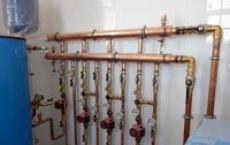The appliance for electric heating at home. Electric heating in a private house - options for heating systems
The importance and need for heating are well known. In cases where it is impossible to connect to central system heating use a variety of autonomous systems, including electrical heating. This type of heating is especially relevant in the conditions of living in a private house, including, outside settlements.
Electricity and heating
Electric heater
Electricity is one of the best achievements of technological progress. Its transmission over electric grids occurs at any distance and with minimal losses, and its use at the place of consumption is environmentally friendly.
Modern electric heating systems and devices are simple, economical, safe in operation, and also are characterized by their compactness and compatibility with automatic indoor climate control systems.
A necessary and sufficient condition for the arrangement and use of heating with the use of electric energy is the availability of a source of this type of energy and reliable, withstand the load of the corresponding devices, power supply networks.
Mounting new and reconstructing existing electrical networks in individual houses requires much less cost than carrying out new or repairing and reconstructing the existing systems of water heating connected to boiler houses where solid or liquid fuels are burned. Comparison of water and electric heating shows that the cost of installing a "from scratch" water, at least three times more expensive. Operating costs, fuel costs, not high efficiency of traditional liquid heating make electric home heating even more preferable.
Planning and Design
Before choosing a heating system based on the principles of the use of electric current, it is necessary to find out the total required power consumption for the future system. This power is determined from the following factors:
- The area of the house.
- Seasonal heating of the house.
Based on the power required for heating, it is necessary to ensure that transformer substation, from which the house is powered, has sufficient power. If the capacity of the substation is less than necessary, it will be necessary to make the necessary arrangements for changing the connection station or increasing the capacity of the existing substation. In case of impossibility of realization of these measures, in order to obtain the required capacity, in order to avoid emergency situations, it is necessary to refuse altogether, or to use it as auxiliary or basic heating with primary or additional, respectively, heating of another type.

Flat heater
The choice is different depending on whether the house is used for living all year round or as a summer residence for the period from spring to autumn. But the most important thing for a home is a thermal insulation, because any perfect, powerful system will not warm if the insulation is in a deplorable state. In addition, significant heat losses will lead to high energy costs.
In terms of safety for consumers, heating electricity is the best among other types. But planning it should take into account the condition and power of the electrical wiring at home, and in the case of a large heated area and, as a consequence, a large aggregate power consumption of heating appliances, a three-phase power network may be required.
In a house under construction, electricity heating is provided for in the main building project to avoid repairs or reconstructions of the building itself during the installation of electric heating equipment. And the installation and implementation of related works will require the involvement of qualified specialists.
Advantages
In general, there are a number of advantages, among which:
- High efficiency.
- Convenience, ease of operation of the system.
- Effective management, regulation of heat output.
- Relatively small dimensions of the heating appliances, which are unpretentious or do not need care.
- Electric heating is highly hygienic and environmentally friendly in operation.
- Noiselessness of the heating system.
- Combined heat supply, using electric heating devices, is universal and allows reducing costs.
Types of electrical systems
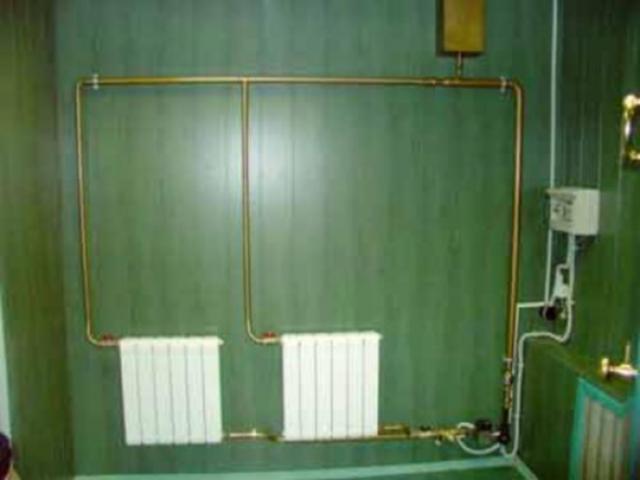
Water heating using for heating the heat carrier of an electric boiler
The most famous and widespread is water heating using for heating the heat carrier of the electric boiler. Boilers are used as the main source of heating or as an additional device used in conjunction with the operation of other systems: gas, solid fuel, diesel.
Electric heating boilers is able to heat relatively large areas, easy to operate, highly productive. But systems with their use are characterized by a number of disadvantages of traditional water heating, due to the need to deliver the coolant directly to heat devices.
Electric direct heating systems are the most promising for Russia and the most popular in Europe. In such systems, the heating of the premises takes place without the use of a coolant - the energy of electricity, converted to heat, transmitted and heated by the building without intermediaries. Heating electrical appliances of such systems by type of heat transfer are divided into convection, radiating, combined. Depending on the method of transfer of thermal energy, the accumulating and directly converting electric power into heat is released.
Convection
In convective air, the heating element flows around the heating element in a forced or natural way, while it heats up and rises, transferring heat to the room. Convectors can additionally be equipped with accumulating devices from materials that are permanently held thermal energy. Such materials are contained in rocks of volcanic origin: talcochloride, steatite, gabbro-diabase.
During the operation of the convection device, the accumulator accumulates thermal energy, and when the device turns off and does not consume electricity - gradually gives off heat. The convector is controlled by electromechanical or electronic thermostats and thermal limiters.
Radiating
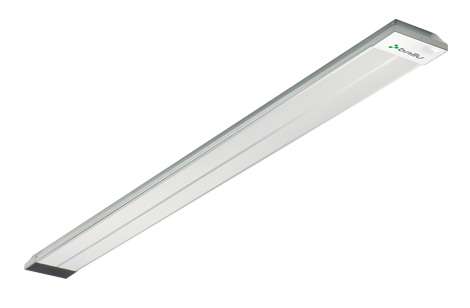
Effective heating of rooms with high ceilings
According to the principle of radiation, electrical panels that transmit heat with infrared radiation operate in a manner similar to the transfer of energy by the Sun. They heat the surrounding space without air circulation, evenly spreading heat in the room with radiation. These devices heat the objects themselves, not the air.
Such panel-type electric radiators can be installed in any convenient place - even on the ceiling. Instrument control, maintenance of the set temperature in the room occurs through a thermal limiter, a power regulator, an automatic temperature regulator.
Combined
Known until recently, combined heating appliances are oil electric radiators, which produce heating due to radiation from the heated surface of the shell and convection. It is controlled like a convector, but most devices are regulated by not very accurate electromechanical thermostats, as a result of this energy loss reaches 15-17%, in comparison with convectors.
Combined devices of the new generation are made from a homogeneous heat transfer material (from aluminum to glass ceramics), heated by the inside of the housing with a fan or another insulated electric heating element. Modern elements of automatic control make these devices as efficient and economical as possible.
System
The electric system of independent heating of the house using the selected electric heaters with their own monitoring devices centrally controls each of them separately and allows saving up to 65% of electric power in the case of using infrared heaters. At the same time, for full-fledged heating, infra-red heaters for floor and ceiling execution are installed, as well as wall systems. Often used combined floor fixtures.
The advantage of electric heaters (radiators, heat curtains, convectors, fan heaters) is the ease of installation and operation. All you need to do is calculate the capacity for a room or the whole house, purchase, and then place the heating appliances in the places chosen for them. The arrangement of electric heating systems does not require considerable effort, as in the case of the installation of water heating systems. As a rule, consumers mount the devices on their own, and in the extreme case they attract ordinary electricians to work.
When it is necessary to equip big house or a cottage settlement, with the use of additional devices for centralized control and management, then invite a specialist who selects the optimal heating scheme.
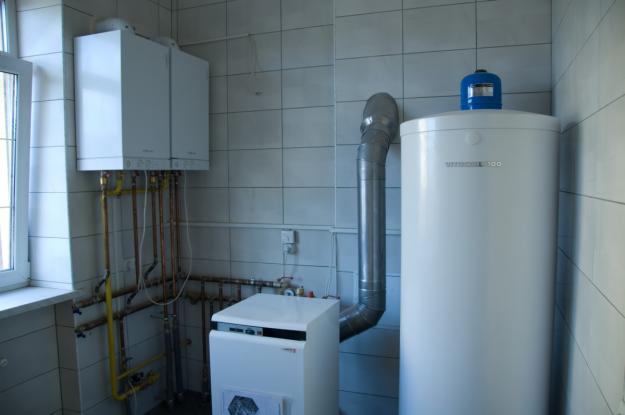
A two-circuit boiler is a very convenient apparatus
Heating by gas today is one of the best. Natural gas is an economical, efficient, safe, environmentally friendly fuel.
Gas and electric heating are close in their effectiveness, safety and a number of other advantages. But with a detailed examination of their specific shortcomings.
Comparison with electric boilers reveals the following. Electric boilers are more expensive than gas boilers, but their performance in some cases is higher, control is more convenient and simpler, and their use is more safe. The electric boiler is only required to connect the power supply, and gas analogs additionally require the purchase of a hinged burner, regular cleaning from fumes and soot. Electric boilers are easy to install, and this is another advantage.
Gas heating requires permission to install it, prepare a place for its installation, wiring the system for it, connect and install all necessary equipment, which in sum is quite expensive. But the monthly payment for heating will be lower than for electricity, although it also depends on the efficiency of the purchased gas system. And the rest of the gas is inherent in the shortcomings of the water system within the interior space, as a system using a coolant.
When comparing gas heating with heating by electric heaters of direct effect, the advantages of electric heating consist in the absence of installation permits, much less capital investments, in simplicity of installation and maintenance. The disadvantage of a more expensive source of energy is electrical.
Conclusion
The use of new technologies and materials for the production of electric heating appliances has made electric heating one of the better ways heating for all relevant parameters. This kind of heating is second only to gas heating - at the cost of heating itself, because electricity is an expensive kind of energy. But the cost of initial capital and regular annual investments in gas heating, according to some comparative calculations to date, will pay off, due to the low cost of gas, only after many decades. Choose the kind of heating to heat the house after taking into account all the specific operating conditions and possibilities.
Radiator in the bathroom
The private house not only provides comfortable living. It also creates a number of problems, the most important of which are water supply and heating. Any errors in the installation of such systems will entail large expenditures. This concerns, and about the advantages and disadvantages of which we'll talk in more detail.
The construction of any communication system requires careful preliminary preparation. Everything needs to be thought through and planned in detail, and also take care of getting the project documentation.
Advantages of electric heating
Ecologically clean electric heating in a private house is used only when there is no possibility to connect to gas mains. Pros for this system is much more than minuses:
- Installed in a private house allows centralized management. This means that you can independently adjust the intensity of its operation and the heating power.
- The system works noiselessly.
- It is compact, reliable and easy to use. It consists of individual elements that are relatively inexpensive.
Minus electrical heating is only one. This is a high price for electricity. But with the use of modern thermal sources, energy costs can be significantly reduced.
Types and features of systems
Today the system of electric heating in a private house can be formed with the help of different equipment. It can be:
- Aluminum, liquid-free radiators.
- System of warm floors.
- Infrared heaters.
A wide range of stationary and stand-alone equipment provides an optimal choice for creating a comfortable microclimate. Let's consider features of use of each kind of the heating equipment.
The system of water heating connected to an electric boiler
Water heating is traditionally considered the most common way of heating living quarters. It is easy to build it in a country house. The standard system consists of an electric boiler connected to radiators by means of pipe lines. It is the boiler that is the heart of the system, and its performance and reliability depend on its performance.

The system of water heating connected to an electric boiler
Modern manufacturers produce boilers, whose capacity is more than sufficient for heating 1000 square meters of space. Their cost is an order of magnitude lower than the liquid analogues. After all, they do not require additional equipment in the form of tanks for fuel, burners, fittings and hoods. For the same reason, it is much easier to install electrical equipment. All the main components are located inside a reliable enclosure in one single unit.
Electric boilers are compact in size, attractive appearance and environmentally friendly. For their installation, no special conditions and separate premises are required. It is enough to hang such a cauldron on the wall, which can be done without attracting a professional workforce. By connecting an electric boiler to a one-pipe or two-pipe water heating system, you can solve the heating problem once and for all a country house. This scheme works on the same principle as an autonomous system with a gas boiler, with only one difference - as the main source of energy is electricity.
The efficiency of the system depends entirely on the correct choice of the boiler. On sale there are two versions of the product - single-phase and three-phase boilers. The second is much more powerful than the first, but they are much more expensive.
The design of modern boilers operates on a step-by-step basis and allows the equipment to be used not at full capacity. This is very beneficial when the temperature outside the window rises, and you do not need to heat the room much. So you can reduce power consumption.
Experts advise choosing models that have software. It allows you to set convenient operating modes and control the equipment at a distance. Buying an electric boiler, it is necessary to determine its working parameters. It is important to know in advance what capacity the equipment needs and which brand to give preference to.
Note! Only original products are able to guarantee the greatest possible effect. Saving in this case does not make sense, since the quality will depend on the reliability of the system.
Aluminum Fluidless Heatsinks

Aluminum radiator radiators
Aluminum radiator radiators are the most advanced technology in the field of heating. Producers position them as a financially viable alternative, which makes it possible to rationally dispose of electricity.
The heat-transfer equipment described above considerably exceeds the cast-iron and steel radiators. Ergonomic shape and compact dimensions, as well as modern appearance, distinguish them among competing products and attract the attention of potential buyers.
For sale, you can find two varieties of aluminum without radiator radiators. Some of them are hung on the walls like batteries, others simply put on the floor. Mobile models are equipped with rollers for convenience.
Having weighed all the pros and cons, one must objectively approach the study of the technical features of the instruments. Carefully get acquainted with their advantages and disadvantages.
Simplicity and availability in operation is not the only advantage of the described devices. They have thermostats, which allow to control the operating modes. Batteries weigh a little, so they are easy to transport as needed. Experts note the high ergonomics of products, their complete autonomy and efficiency.
Since the switch-on takes very little time, and the battery starts to warm up the air. Aluminum radiator radiators show great reliability. In the absence of electricity, there is no danger of freezing the heating system, and this distinguishes such equipment, for example, from the water system. In our country there are frequent cases of switching off the light, so do not take risks with the installation of electric boilers.
In addition, all aluminum liquid-free radiators have a double overheating protection network, so manufacturers guarantee long-term operation.
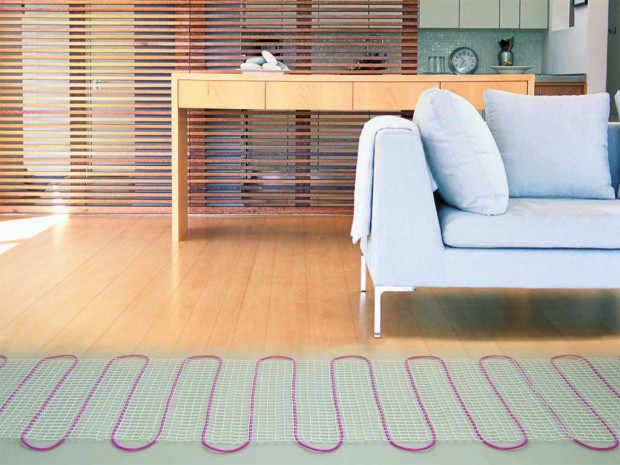
System of warm electric floors
As you can see, it can be different. There is another option - a system of warm floors. If it is necessary to heat a large area, select a system of water-heated floor with connection to the electric boiler. Small areas are heated using a cable system.
Cable floor heating operates on the principle of converting electricity to heat. In special mats, a heating conductor is built of special copper alloys with high resistance. Through the veins pass current, they heat up and give off the heat of the finish surface of the floor.
This method of heating is environmentally safe. The electromagnetic field, which creates the heating core, is 60 times lower than the permissible values. Infrared film, which increases the efficiency of the system, has a power of 200 W / sq.m.
The water-heated floor uses water as a source of heat, which is heated by an electric boiler.
Warm electric floor has several advantages:
- It provides a visual absence of heating devices.
- Electric mats can be installed without the use of special equipment.
- The system ensures an even warming up of the room.
- Heat from the floor is more comfortable perceived by a person at the physiological level.
- If there is a need for repair, you do not need to open the entire system, since there is a possibility of local troubleshooting.
The disadvantage is still the same - large expenses for electricity. And also the presence of electromagnetic radiation.
Note! Doctors warn that the exploitation of large surfaces of warm floors adversely affects the overall well-being of a person due to the fact that the air in the room becomes very dry. As a rule, this leads to drying of the nasopharyngeal mucosa, which makes it sensitive to infection.

A great choice for summer cottages
Recently, both specialists and consumers have become increasingly interested in infrared heaters. The principle of their action was borrowed from nature itself.
Infrared waves do not heat the air. They heat objects in the room, which then give their heat to the surrounding space. Even if you turn off the heater, the house will still have a very comfortable temperature for a while, and this allows you to count on significant energy savings.
This type of heater is completely safe for humans. Moreover, the heat produced by it is more comfortable for us all from the physiological point of view. It has a positive effect on the body. Infrared waves kill bacteria, improve blood circulation, stimulate the acceleration of metabolism. Scientists managed to create a completely new source of heat, the efficiency of which is above 90%.
Install the infrared heater can be on the ceiling and on the wall. It practically does not have any drawbacks. Such a device could be called universal if it were not for one "but". When the power is turned off, infrared heaters will not work either.
Generalization on the topic
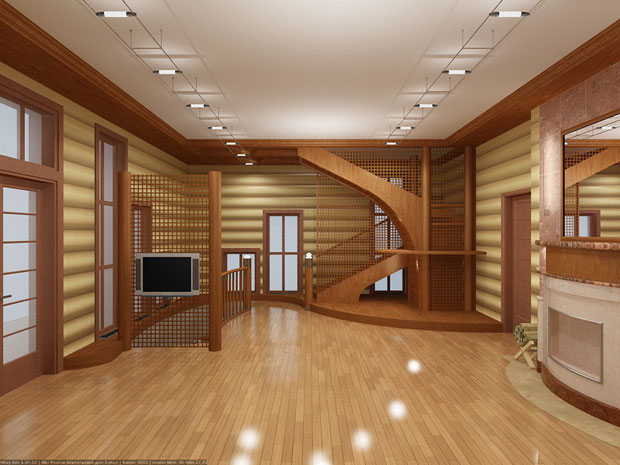
Energy-saving film infrared electric heating
As you can see, the variety of heating electrical equipment allows you to make the best choice in each case. So, for example, for heating small rooms - bathrooms, hallways, kitchens or pantries - you can choose aluminum without radiators or warm floors.
But for bedrooms and a living room it is better to conduct a system of water heating and purchase an electric boiler. For heating an indoor swimming pool or a winter garden, infrared heaters are ideal, which simultaneously warm all objects in a spacious room.
Many combine different types of equipment. In order not to freeze on the day of switching off the light, we advise you to additionally build wood stoves or fireplaces. In any case, it is better to calculate the existing risks beforehand so as not to regret the wasted money.
One of the most pressing issues for owners of country houses, houses, cottages, bathhouses, and other buildings of country type, is the issue of heating. To date, there are three main types: solid fuel, gas and electric heating. Let's try to figure out which is still better. We calculate three variants of 90m 2.
Options for heating a country house and calculating prices
so , solid fuel. Solid fuel boilers they are quite simple and durable, they work on virtually all types of solid fuel: wood, coal, peat, pellets, briquettes, etc. The use of various briquettes, pellets or pellets is quite expensive, as manufacturers supply their goods at inflated prices. Coal, in my opinion, has some territorial affiliation., In regions where there are mines it is more accessible, although there the price for it has risen very much, and accordingly, the transportation of coal to other regions increases its value at times. Therefore, the most common fuel for solid fuel boilers is firewood. For heating the house 90m 2., With permanent residence, it will take 2-2.5 m 3 firewood per month. The cost of one cubic meter of firewood (chipped) from 1500r. (for calculation the cost of firewood in the Leningrad region is taken). Thus, by simple mathematical calculations, we get the cost of heating the house 90m 2 within one month is 3000-3500r. On average, the heating season is 7 months, that is, 14-15 m 3 firewood is needed.
Let's calculate the approximate cost of a solid fuel heating system (economy):
- Heating boiler solid fuel 20000r.
- Radiators 7pcs to 3000r = 21000r.
- Installation of the system (including pipes, fittings, adapters, etc.) 50000 rub.
Total: 91,000 rubles.
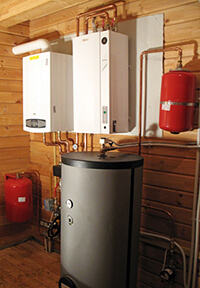 Gas.
Gas heating is one of the cheapest sources of heat. Of course this is so, if you have a pipe layout, a gas boiler is installed and gas is injected into the site. Let's try to calculate the cost of installing and owning gas heating from "zero".
Gas.
Gas heating is one of the cheapest sources of heat. Of course this is so, if you have a pipe layout, a gas boiler is installed and gas is injected into the site. Let's try to calculate the cost of installing and owning gas heating from "zero".
- Radiators 7pcs. on 3000 = 21000r.
- Gas boiler 40000r.
- Installation of the system (including pipes, fittings, adapters, etc.) 50000 rub.
- Gasification project, connection, coordination from 300000r
Total we receive 412000r., (In practice it turns out not less than 500000r.)
It is believed that for heating a 10m well-insulated house requires a boiler capacity of 1 kW, when choosing the specific power of the boiler, it is necessary to take into account the climatic conditions of the region:
- For the central regions, Wd = 1.2-1.5 kW;
- For the North W w = 1.5-2 kW;
- For Southern W ud = 0.7-0.9 kW;
hence for a house with an area of 90m 2, in the central region you will need a boiler:
W of the boiler = 90х1,2 / 10 = 10,8 power of 10,8кВт.
On average, the boiler will work 50% of the time = 5.4 kW / hour.
The calorific value of 1 m 3 of gas is 9.3 kW / h The cost of 1 m 3 of gas (after the last increase in tariffs) is 5.03 p. Hence 1kW. heat, with a boiler efficiency of 95%, costs us about 0.45 rubles.
The heating period lasts about seven months, we get. 5,4 kW / hour. Х 24hours X30 days = 3888 kW multiplied by the cost of 0.45 rubles = 1750 rubles per month; multiply by seven months, we get 12250r. for the heating season.
«Energo Effect» . Now calculate the cost of installation and ownership of the system of electric heating "EffectEnergo" for the same house area of 90m. For heating a country house with electricity you will need:
 1st floor
1st floor
- Kitchen-dining room 10.76m is installed one radiator EEE 1200/6 with a capacity of 1.2 kW. The price is 18800 p / pcs.
- Living room 15.44m under each window installed radiators EE 800/4 with a capacity of 0.8 kW. Price 15,800 r / pcs.
- Hall 9,66m is installed radiator EEE 800/4 with a capacity of 0.8 kW. Price 15,800 r / pcs.
- A 5,13m bathroom is equipped with a radiator EEE 600/4 with a capacity of 0,6kW. Price 14500 p / pcs.
- Tambour (at the request of the customer) one radiator EEE 600/4 with a capacity of 0,6 kW. Price 14500 p / pcs.
The need for a boiler room disappears, you can use it as a wardrobe or a storeroom.
2nd floor.
- Bedroom 10,53m is installed one radiator EEE 1200/6 with a capacity of 1.2 kW. The price is 18800 p / pcs.
- Bedroom 15.21m installs one radiator EEE 1600/8 with a capacity of 1.6 kW. Price 23900 p / pcs.
- Hall 7.61m installed radiator EE 800/4 with a capacity of 0.8 kW. Price 15,800 r / pcs.
- Bathroom 6m is installed radiator EEE 600/4 with a capacity of 0.6 kW. Price 14500 p / pcs.
The total cost of electric heating of a country house 90.49m with Electro-radiators "EffetEnergo" of the "Economy" series is 152400 rub .
- Installation of one radiator 500r., We get 10pcs. on 500r = 5000r.
Total: electric heating plus installation = 152400 rub.
- The peak power of electrical heating will be 8,4kW. The average consumption for the heating period is 2.5-3 kW / hour.
- The cost of ownership of this system of electric heating with a one-rate meter: 3 kW / hour * 24 hours * 30 days / month * 1.92r (one-part tariff in Len.obl.) = 4147r. per month. For the heating season 4147 * 7months = 29029r.
- The cost for a two-rate meter is 3450 rubles a month.
- The cost for the season is 24150 rubles.
- Installation of electrical heating for this cottage 2 hours .
| Cost of heating / month | Cost of the heating system | Annual Service Cost | The cost of heating a year (7 months o / s) | |
|---|---|---|---|---|
| Firewood | 3500* | 91000* | 8000* | 32500* |
| Gas | 1750* | 412000* | 10000* | 22250* |
| EffectEnergo | 3450* | 152400* | no | 24150* |
* — The calculations are for informational purposes only and the prices may differ from the actual ones at the moment.
So, based on numbers and mathematical calculations, we get:
1. If you are not a smart woodcutter who can easily lay five or two unfortunate trees in the forest (by the way, illegal logging is a criminal offense, Article 260 of the Criminal Code of the Russian Federation.) Then heating with wood is an expensive and rather troublesome business.
2. Gas heating (when calculating all the components) is cheaper than the heating EffectEnergo for two thousand rubles a year. The difference of initial investments is 260 thousand rubles. Of course, if you are a longevity, and the prospect of paying off investments in gas heating for 130 years you are not scared, then this way for you. If not ...
Summary: Heating electricity in a private home is the most popular in Europe. This type of heating is convenient, safe and environmentally friendly.
Maybe you are interested in:
Popular Electro-Radiators

Design solutions offer electric heating of a country house as the easiest to connect to a common electrical network and operation of heating devices.
In addition, the technical variety of heating equipment provides the option of selecting the most economical option under specific conditions.
Electric heating systems for the house can be:
- basic;
- additional;
- reserve.
The latter maintain the necessary temperature in certain parts of the room, preventing the pipes or plants from freezing in the winter garden during the cold season, stopping work when the main heating is activated.
Electric house heating is calculated according to the scheme, according to the architectural and planning decisions of the project and the technical parameters of the equipment, as well as the requirements for maintaining comfortable conditions in the premises.
Mostly in the heating scheme include:
- electric boilers;
- electric convectors;
- electric infrared heaters.
Equipment for electrical heating systems
Electric heating boilers for the home are among the most environmentally friendly.
- Do not create products of burnout;
- Do not require an additional device ventilation ducts and chimneys;
- Their placement is allowed in common areas as the safest in operation;
- Low noise level with the mode on is also one of the positive moments of comfort;
- The efficiency of modern electric boilers does not decrease for 93%.

- Electric boilers are easy to install and unpretentious in maintenance, most often equipped with an additional fuse, triggered by a decrease in the voltage in the network.
Equipped with light indicators, allowing to control the operation modes of the boiler. - There is also a smooth temperature control and a two-stage protection against overheating of the TEN. Themselves are made of stainless steel with the maximum resistance of the insulating material.
- Thanks to the use of special programmers are in the most economical modes of power consumption and are no longer the most expensive of all types of boilers.
Classes
Boilers are in different economic classes, which also takes into account the technical capabilities of the equipment:
- standard-economy;
- standard;
- comfort;
- professional;
- lux;
- gSM-Slimate module.
The most simple and economical boiler of the standard-economy class ensures complete safety and automation of work, providing comfortable conditions in the room.
Higher classes provide connection of additional equipment, temperature control in different modes, full climate control in the room with the help of specially connected devices. Accordingly, the provided services increase and the price of the boiler.
Induction boilers are an economical option for electric boilers. Using induction boilers reduces heating costs by 30%, while the cost of the boiler remains at the level of a conventional boiler with a TEN.

Induction boilers have a high operational safety, because the heating element works by creating a magnetic field, not directly touching the current.
Automation systems
To achieve an economical heating system, it is important to properly build the circuit itself, and then provide control of its operation using modern automation.
Automation systems are used:
- mechanical;
- electronic.
Mechanical automation systems are now mainly used in auxiliary and storage facilities, since they are economical and create noise during operation.
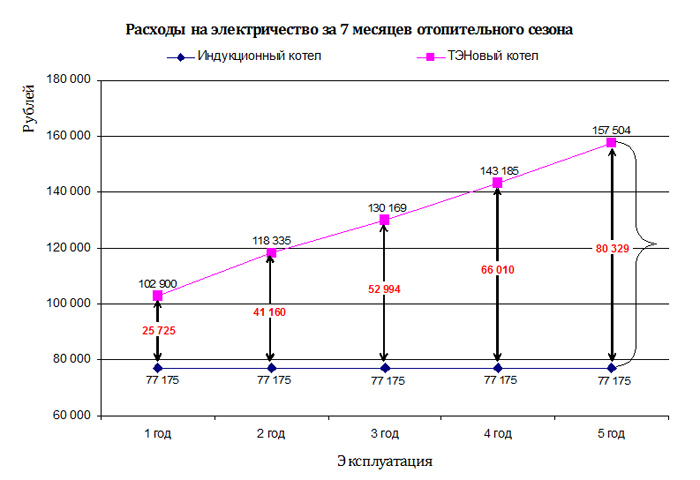
Electronic automation systems are much more precise in control and almost noiseless. If you set the sensor to adjust the heat supply based on the set room temperature, the efficiency of using digital automation increases by 15% due to rational energy consumption.
Installation
Installation of systems is not a technology of high complexity and with the necessary knowledge it is quite possible to mount a heating system by one's own hands.
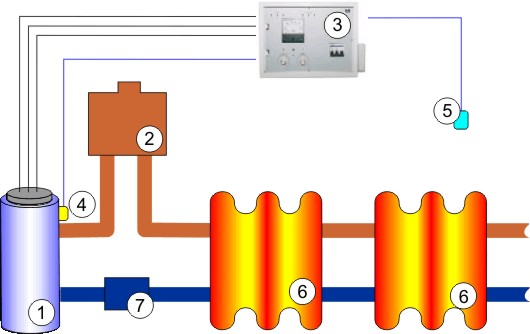
Scheme of equipment placement in electric heating
The installation instructions for the heating system include a heat circuit, a list of necessary skills and an approximate calculation of equipment for heating a standard room - a living room, a greenhouse or another.
Most often the system includes:
- electric water heating boiler;
- tubular heaters;
- circulation pump;
- system of fluid distribution through the premises;
- heating radiators for heat recovery inside the room.
Look at the video of the installation of electrical equipment:
Council. When installing the heating system, take into account that different volumes of rooms require an additional number of sections of batteries for heat release and the wrong number of sections can serve as underheating or overheating of the room.
Features of installation of safe electric heating in wooden houses
Electrical heating of the wooden house is made on the basis of the project and the planning decisions laid in it.
In the heating system, electric boilers with solid fuel of hot water type participate.
- When installing a solid fuel boiler, more heating liquid is needed, for which additional storage tanks of heated water for circulating in the system are used.
- Heat output occurs through convectors or heating panels. In the organization of air heating, warm air is stored in the heat exchanger and diluted by the air duct system through the rooms.
- Laying of electric cable and wires in wooden houses made in special metal fireproof sleeves or other non-combustible materials, as shown in the photo.
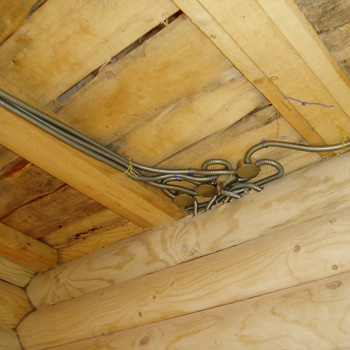
- In the heating system of a country house it is important to maintain a constant temperature in the premises during the working week, if living in the house only on weekends. It is advisable to choose an additional or reserve type of pulse heating.
- The use of infrared heaters, which consume resources economically and provide the necessary heat level and are safe thanks to automatic thermal control systems, has proved to be very useful.
- It is also rational to use them because of point-directed heating of outdoor places in the cold season.

Conclusion
Thus, electric heating of a country house has become a convenient, simple and economical way to achieve comfortable living conditions. Correctly selected equipment will save you from the hassle of maintaining climate control and give warmth in the house.
The choice of a heating system is a key issue, from the solution of which depends the comfort of living and the safety of the owner's finances. Considering the various options, it is worth paying attention to the electrical heating in a private house. Modern systems operating from electricity are very diverse and not all of them consume an excessive amount of energy. Let us consider each of them in detail.
Therefore, their advantages are somehow not taken into account.
Electric heating systems are among the most environmentally friendly. They do not give any emissions into the atmosphere
This is fundamentally wrong, because electrical systems have many significant advantages that distinguish them from other types of heating:
- Security. The equipment does not work with open flames and explosive substances, like other heaters. Qualitatively laid wiring - a reliable protection against possible fire.
- Easy to manage and maintain. Automatic systems regulate the operation of equipment, which requires minimal human intervention. Elements that require regular replacement or cleaning are not available.
- Complete environmental safety. When working, the system does not emit toxic substances, so it can be installed in any premises.
- No need to store fuel. Therefore, no special room is required for the storage of combustible materials.
- Compactness. Most of the equipment is small in size. A variety of design devices allows you to easily choose a model for anyone in the style of the interior.
- Low cost. In comparison with other types of heating appliances, the price of such equipment is much lower.
Of the significant disadvantages of electrical systems in addition to the fairly high cost of electricity for the sake of justice, one should note the complete energy dependence of the equipment. This means that when the power supply is cut off, all appliances will stop working, which will be especially noticeable in areas with frequent outages. In addition, for the uninterrupted operation of the equipment you need a powerful electrical network, which is not everywhere.
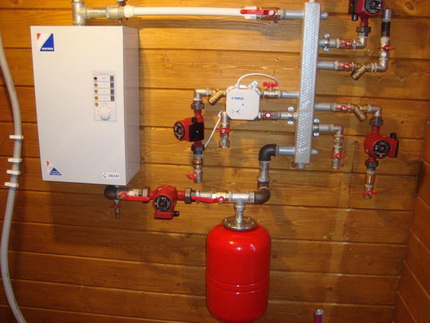
For the arrangement of water heating with an electric boiler, only closed system with fitted diaphragm expansion tank, by means of which the pressure in the system is regulated
Water heating with electric boiler
It is a standard system with a liquid coolant circulating through the heating circuit. Its main difference is that heating of the coolant is made only through the use of an electric boiler. Because of this, such a system will have some features. First of all, it can only be closed type and should be equipped with a membrane expansion tank.
Otherwise, it will not be possible to avoid uneven heating of rooms, loss of speed and power of heat exchange, which will lead to over-consumption of electricity and, accordingly, unjustified expenses. For the same reasons, it is not recommended to install a system with natural circulation. The best option – forced circulation coolant, which will make it possible to save energy as much as possible.
Three types of electric boilers can be used to operate this heating system. We will analyze the merits and demerits of each of them.
Boilers with heaters type TEN
In each of these devices are installed heating elements. These are heating elements operating on the principle of resistive heating of a conductor through which an electric current passes. Due to the fact that they have to work in the liquid, the devices are additionally protected in the form of a waterproof housing and reliable insulation. Therefore, the power of the heaters is somewhat reduced.
![]()
The figure shows the design of an electric boiler with a TEN heater
As a result, the efficiency of each such heater is not more than 80. Therefore, in order for boilers of this type to heat the coolant to the desired temperature, it is required either to increase the number of heaters or to place heaters of higher power. In any case, energy losses are inevitable, which negatively affects the economics of devices of this type. Most often in one boiler manufacturers install 3-4 heating elements.
Different modes of operation of the device are envisaged. Depending on this, all heating elements, only one or a group of elements, can be included in the work. The power of electric boilers of the TEN type varies from 3 to 50 kW. The most powerful models are designed to connect to three-phase network, less powerful can work from single-phase.
The arrangement of heating elements in the device can be different, which affects their appearance. They can be made in the form of cylinders with "hidden" inside the heating elements and taken out in a separate housing by the control unit or have the usual rectangular shape with the control elements withdrawn to the housing. The cost of boilers of this type is very low, which is due to their inefficiency.
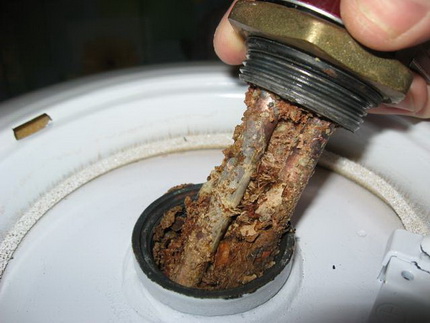
During operation, the surface of the heating element is covered with scale and salt deposits, so it must be regularly changed
TENovyh devices have other drawbacks. First of all, this is a short term "life" of the heating element. In the process of using the device, it is covered with salt deposits and breaks down. Therefore, a regular change of TENS to such an instrument is necessary. Another "minus" is that when starting up the equipment with a small amount of coolant or in its absence, the heaters fail.
Boilers with an electrode principle of action
The principle of operation of the device differs radically from TEN models. To obtain heat, frequency fluctuations are used in a variable network, which in turn cause oscillations of ions in the electrolyte, which leads to its rapid heating. Actually, the boiler is a housing with two electrodes immersed in a coolant, the role of which is played by a conductive liquid or electrolyte.
Most often, antifreeze of this or that brand is used for this purpose. Electrode devices favorably differ in their compactness and low weight, while their heating power is high. Such boilers can be installed in groups, launching one or more instruments as needed at once. Another advantage of the electrode equipment lies in its almost total insensitivity to voltage drops in the network.
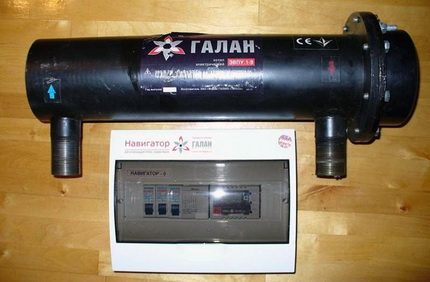
Electrode boilers are very compact, which distinguishes them from analogues of TEN type
A safe range for them is 15-20%, which is quite a lot. However, stability of the frequency of alternating current is very important for devices. Electrode boilers are completely fireproof, as such a device can not overheat, and in the absence of a coolant it simply does not turn on. The appliance heats up very quickly. In terms of efficiency, it is 20% higher than the TEN analog, that is, its efficiency is about 98%.
However, its performance can be increased. This is achieved by tying the device with metal pipes. Thus, the ionization zone of the coolant significantly expands, which gives the effect of increasing productivity. The cost of electrode boilers is low. Therefore, when such equipment only appeared, it was considered almost an ideal heating device.
However, in the process of exploitation, shortcomings also emerged. First of all, this is not a stable power of the device. It depends very much on the chemical composition of the conductive liquid and its temperature, since even with small deviations the electrical conductivity of the solution changes, which leads to changes in the intensity of heating. In addition, the electrode system is very difficult to automatically control and adjust.
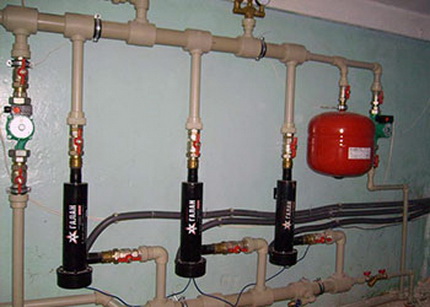
Electrode boilers can be installed in groups, which makes them much easier to operate
For boilers of this type, the purity of the coolant is extremely important. In the case of non-compliance with the proportions of the solution or its contamination, all the advantages of such a system are lost. Therefore, at least once a year, the correction of the chemical composition of the electrolyte is required. With the same periodicity it will be necessary to clean the heat exchanger and the entire heating system from salt deposits, which will accumulate quickly enough.
A prerequisite for connecting an electrical heating system at an electrode type house is the presence of a ground loop. Thus, in spite of the fact that such heating devices are more economical than their TEN analogues, they do not use special demand. A sufficient number of drawbacks make their use for heating a private home not entirely convenient.
Heating boilers of induction type
These are the most advanced representatives of electrical heating systems. At the heart of these devices is the principle of electromagnetic induction. Everything happens as follows. An electric current is passed through the primary winding located in the core of the device. It induces a voltage in the secondary winding located closer to the body of the device. It is a labyrinth system of pipes through which the coolant passes.
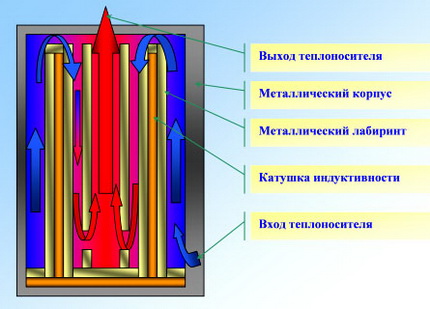
The figure shows schematically the induction boiler and the principle of its operation
When the secondary circuit is closed, a resistive heating of the conductor occurs, and, accordingly, the heat carrier. There is no loss of energy at all, so the efficiency of such a system is almost 100%. The heating of the liquid takes place very quickly and evenly. Induction boilers are very economical. This index increases even more due to self-induction of the system, which is associated with additional reactive power.
It produces currents passing through a secondary closed loop. At the same time, the values of the emerging additional power are sufficiently large. The version of the inductive boiler - a vortex induction heater or VIN - acts differently. On its primary winding comes a voltage, which is previously converted into a high-frequency. Thus, the intensity of the electromagnetic field increases sharply.
What gives the same rapid increase in current that is generated by this field. The peculiarity of the VIN boiler is that it does not have a secondary winding. All metal surfaces of the equipment are used instead.
They are specially made of materials with pronounced ferromagnetic properties. The appearance of eddy currents leads to a magnetization reversal, which causes a strong and almost instantaneous heating of the ferromagnetic alloys.

Induction boilers are compact, but they have considerable weight
Consequently, practically all the massive elements of the case participate in the heat exchange process, which makes it possible to obtain a very high efficiency approaching 100%. Induction boilers of both varieties are distinguished by their considerable weight and relatively small dimensions. They can be installed one by one or by groups, the latter provides significant advantages in the organization of heating the building.
The advantages of induction boilers include fast, almost instantaneous heating. The equipment is easy to adjust, therefore, automatic control units are mounted on it, providing precise settings. In terms of electrical and fire safety, these devices are most favorable when compared with analogues of other types.
The high efficiency of induction devices does not decrease even after a long period of operation. This is due to the fact that salt deposits or scales do not accumulate inside the device. They are removed by high-frequency microvibrations that accompany the operation of the equipment. For the same reason, there are no special requirements for the chemical composition of the coolant. Boilers are insensitive to it.
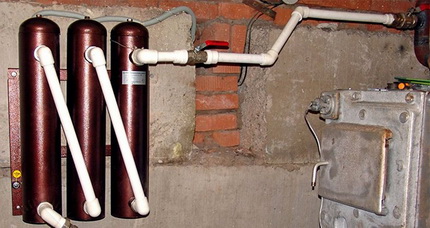
The use of induction boilers gives an energy saving of about 40% compared to the use of electric boilers of other types
Another advantage is the long life of induction boilers. Without exaggeration, it can be estimated in tens of years. This is because there are simply no vulnerable nodes for the equipment. The contact of the electrical part of the device with the heat carrier is completely absent. Problems can arise only with welds, which usually serve for a very long time. The main advantage of this type of equipment is its economy.
Practice shows that it allows you to save up to 40% of electricity compared to its TEN and electrode analogs. Among the shortcomings, it is worth noting a small vibrational noise, which is produced by the boilers during the work. Massiveness, which requires attention during installation, especially if the device is mounted on a wall. Another disadvantage is the relatively high cost of induction devices.
Infrared Heating Equipment
To heat your country house with electricity you can use modern systems infrared heating. For their work, the principle of wave energy transfer is used for some distance. Everything happens as follows. Emitter converts electric power into the wave of the infrared and transmits it. The waves move until they reach any opaque surface.
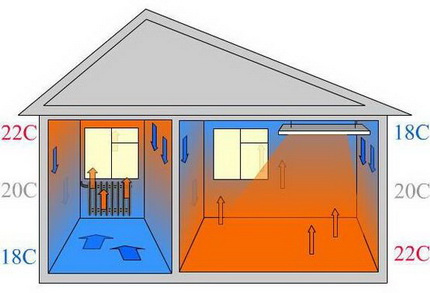
Temperature distribution when used infrared heating much more comfortable for a person than using traditional heating methods
Here they are transformed into thermal energy, heating the body that met on their way. The object heated up in this way, whether it is large furniture, floor or wall, begins to give heat to the atmosphere, thereby heating up the air in the room. Thus, the most uniform heating of the room occurs, and the temperatures are distributed in the most comfortable way for a person.
At the same time, there is practically no energy loss, which causes high efficiency infrared heaters. They are available in different versions. Especially popular is a special film with sealed in it carbon radiators. It is used to build a system of warm floors, it can be used on the ceiling and on the walls. The film is closed with any finishing material, which does not affect its properties.
The thickness of the infrared film is small, it is invisible under any coating. The system is moisture resistant, it is not afraid of dynamic loads. It must be dismantled and used again. On sale you can find infrared heaters in the form of plates of various sizes. They are also designed to be fixed on walls or ceiling. However, in this case it is rather a question of additional heating, rather than the main one.
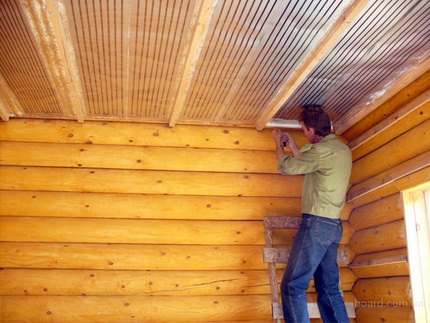
Infrared film can be covered with any finishing material. This does not affect its properties in any way
In terms of efficiency, infrared equipment outperforms all known electrical heating systems. This is because he can very quickly heat up the room, after which the automatic control unit periodically turns the device on / off, maintaining the desired temperature regime. The disadvantages of infrared systems include a strict heating direction.
The device heats only the area located in front of it. Therefore, for example, infrared film, laid on the entire perimeter of the floor or ceiling. Another disadvantage is the relatively high cost of such equipment, especially if you need to purchase material for floor heating or a ceiling PLEN system. However, we must admit that such investments of funds pay off fairly quickly.

Modern infrared heaters can be made in the form of a decorative panel
Heating electric convectors
The operation of these devices is similar to the operation of heating radiators. They also warm up and transmit heat to the air around them. The difference is that there is no coolant in the convectors. Therefore, systems of supply / discharge pipes are not needed. Instead, heaters are placed inside the device, which heat its surface. For the intake of cold air, the lower part of the device is intended.
It penetrates inside the convector through a special mesh. Heating from the TEN, air rises higher and exits through the upper grate. During the work of the heater, a steady upward flow of warm air is created, which quickly heats the room. To regulate the heating temperature, the equipment is equipped with a thermostat, an automatic control unit can be installed.
Manufacturers produce a wide range of devices of different power and design. For rooms with high humidity, you can purchase devices with special protection. Convectors are extremely simple to operate and safe. The heating element of the device is inside its housing, the external panel is heated very little, so it is impossible to burn it.
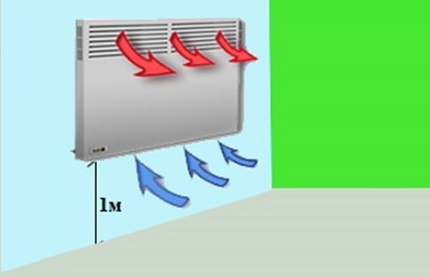
The diagram shows schematically the principle of the electric convector: cold air masses are tightened by the device from the bottom and after the treatment are output outside at the top
Heating devices are noiseless, so they do not create any inconvenience. Various variations of convectors are produced, among which there are mobile portable models. There are devices intended for installation in the floor. They are installed under the windows, in front of doors and in other similar places, where the devices create an effective heat curtain to prevent cold from entering the room.
Negative characteristics of convectors include their small power. Therefore, to heat the building will require a fairly large number of them, which is a serious load on the wiring. In addition, the cost-effectiveness of such devices is low. They consume quite a lot of electricity.
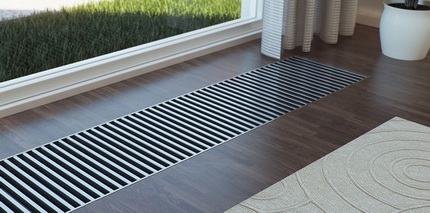
A type of electric convector that is built directly into the floor
Electrical systems "warm floor"
Their principle of operation is to use resistive conductors, which are heated when electric current passes through them. The device is a heating cable, which can be two or single-core, which determines the way it is laid. There are varieties equipped with a semiconductor matrix. These are so-called self-regulating cables capable of controlling heating.
To arrange a warm floor can be taken from the heating cable, which is laid directly on the screed. There is no other installation option for it. In this case, the cement screed becomes a kind of heat accumulator. More convenient for laying option - electric mats. They are the same heating cable, which is fixed to a grid of fiberglass.
The advantage of mats is the possibility of laying not only in the screed. In some cases, for example, ceramic tile, such a system can be laid directly into the glue, the layer of which will need to be slightly increased. The main disadvantage of both versions of the cable floor can be considered that if one of the sections of the system is damaged, the part of the structure behind it breaks down.

During installation, the heating cable is laid so that its sections are not in contact
This drawback is devoid of core heating mats, which are pairs of conductors connected in parallel by rods. The system operates on the principle of self-regulation of the degree of heating. Warm floors of any type are equipped with a thermostat that controls the heating of the device to a certain temperature, after which the equipment is switched off.
Periodic automatic system activation is performed only in order to maintain the set temperature. This mode of operation saves energy, but such heating is still quite energy-intensive. Therefore, it is often used as an additional heating system and for equipping in rooms of particularly comfortable warm zones. This can be, for example, areas for children's games or the floor in the bathroom.
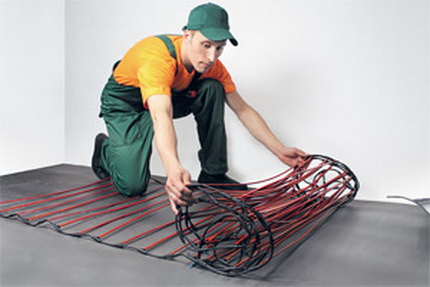
Rod systems continue to work even if one of the elements fails
Video materials illustrating the topic of the article
Video review will tell you which of the electric boilers to choose for your home:
Let's consider features of various types of electric warm floors:
How infrared heating works:
Oil radiators, electric heaters and similar equipment can be classified as "yesterday". To organize with their help a full heating is almost impossible. In addition, they are very uneconomical, so electricity bills will simply be cosmic. The above electric heating systems are effective and can be used for private houses. It is important only to warm the building well, otherwise you will have to pay too much for electricity.



